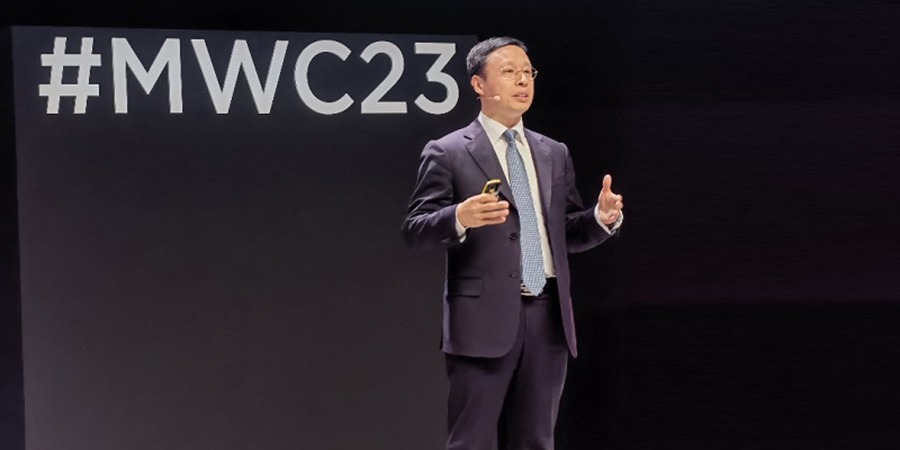The Huawei Product and Solution Launch 2023, held as part of the Mobile World Congress agenda, featured the president of Huawei Optical Business Product Line, Richard Jin, among its roster of speakers.
Jin proudly announced the launch of the three latest optical solutions from Huawei: FTTR OptiXstar F30, the industry's first commercial 50G PON, and Huawei OptiX Alps-WDM. These three solutions are designed for the fields of all-optical home, all-optical metro, ultra-broadband access, and all-optical metro.
Moreover, while helping operators build E2E green all-optical networks, these solutions also support the smooth evolution to F5.5G networks to achieve 10 Gbps Everywhere.
FTTR OptiXstar F30
Since its release in 2022, the Huawei FTTR has been adopted by more than 90 major operators worldwide. Boosting the all-optical home field, the Huawei FTTR OptiXstar F30 is the industry's first all-optical 2,000 Mbps FTTR networking product. It uses a C-WAN architecture to implement six major improvements: aesthetics, speed, coverage, roaming, concurrency and service.
It has four colors and three installation modes, allowing it to blend in perfectly with the design of a modern home, and a 2,000 Mbps connection that can be ensured throughout the entire house. Its multi-beam smart antennas improve coverage by 30%, while its unique imperceptible roaming reduces the handover latency to less than 20 ms.
Impressively, the Huawei FTTR OptiXstar F30’s multi-AP coordination minimizes Wi-Fi interference and allows up to 128 devices to access the network simultaneously. Moreover, this new solution has one-stop premium 5A1 service capabilities for operators.
“Huawei FTTR OptiXstar F30 is the most innovative home broadband solution where you can get gigabit Wi-Fi in every corner of the home. Therefore, I believe that the new FTTR will bring benefit to both users and operators,” explained Jin.
50G PON
Huawei's 50G PON solution provides the optimal evolution path for upgrading to 10 Gbps. In the ultra-broadband access field, the Huawei 50G PON solution is the industry's first commercial solution to implement the four core functions, namely: high-density symmetrical 50 Gbps upstream and downstream service capabilities; an innovative tapered amplifier and a superlattice reflection structure; service upgrade with the integration of GPON, 10G PON, and 50G PON; and compatibility with the existing commercial OLT platform.
With these capabilities in tow, industrial interconnection, enterprise, and home scenarios will have the bandwidth to spare and can thus achieve an optical power budget of up to 32 dB as well as reduce operator investment costs.
“With all this technical breakthrough, Huawei’s 50G PON can provide an ultimate evolution to current PON networks,” Jin underscored.
Alps-WDM
In the all-optical metro field, the Huawei OptiX Alps-WDM solution provides four capabilities: all-optical switching, full coherency, fully pooled architecture and full automation.
It has the capability to extend Optical Cross-Connect (OXC) to the aggregation and edge layers and enables one-hop connections and flexible grooming on the entire network. It also has a custom 100G M-QPSK modulation format and an integrated coherent transmitter/receiver (ICTR) that deliver 100G and a 10-fold higher bandwidth.
Significantly reducing network construction CAPEX, Alps-WDM’s new subracks can replace nine traditional subracks, while digital optical labels use one-click automatic O&M to reduce OPEX by about 90%.
“Alps-WDM can help operators build a future-oriented, most TCO-effective metro network,” stated Jin.
"From F5G to F5.5G, we need to plan and create the future. Today, gigabit connectivity is rapidly growing more popular all over the world. Looking towards 2025, diversified network requirements will require ubiquitous 10-gigabit connectivity. All industries need to work together to embrace F5.5G and move towards 10 Gbps Everywhere,” the Huawei executive elaborated.
“Huawei will join hands with global operators to accelerate network upgrades and the application of new technologies, helping operators continuously expand their business boundaries and seize opportunities with ultimate user experience to lead the future,” he continued.
During the Q&A session, Telecom Review asked Jin about the brand-new metro WDM solution’s advantages, product availability and commercial site launch.
“Apls-WDM is one of the most important innovations in Huawei's optical products in the past 20 years. We hope this most TCO-effective metro OTN solution can help carriers build a future-proof all-optical network and support the rapid development of their FMC services. Its TCO advantages come from the four aspects:
First, OXC is deployed on CO nodes to support flexible and efficient wavelength grooming through E2E all-optical switching. No more complex configurations and manual fiber connections, shortening the time to market (TTM).
Second, with the highly integrated WSS module, 9 dedicated access rings are fully connected at the aggregation node. Wavelength resources are pooled and shared among the 9 rings, greatly improving wavelength utilization. At the equipment level, 9 subracks are combined into 1, significantly saves the space and power consumption.
Third, we have developed customized 100G modules for metro, allowing operators to deploy 100G to COs, improving network capacity and greatly reducing network construction costs.
Fourth, we add digital optical labels to each wavelength. With the centralized computing and management capabilities of NCE, planning, construction, and O&M are highly automated, reducing labor costs.
The Alps-WDM solution has been piloted in China Unicom and will be launched globally at the end of March this year.” he responded.
Huawei's OptiX Alps-WDM solution is agile, intended for long-term evolution, has innovative pooling architecture and a simplified, colorless ROADM.
"Huawei has been committed to strategic investment and technological innovation in the optical communications field for many years, empowering operators to build ubiquitous premium connectivity," Jin offered in conclusion. “It will help build all-optical metro networks with an optimal TCO, accelerate all service development for operators, and achieve the vision of Premium Connectivity Lighting Up the Digital World.”










